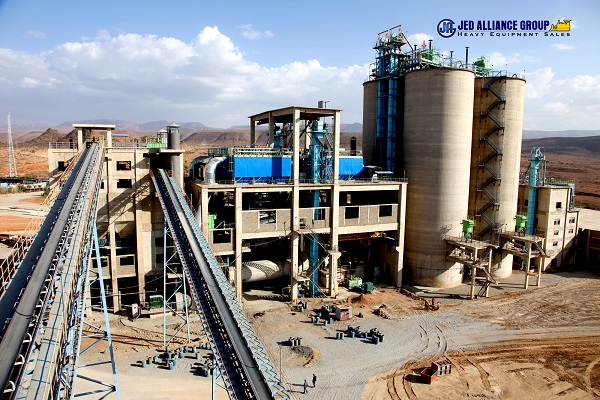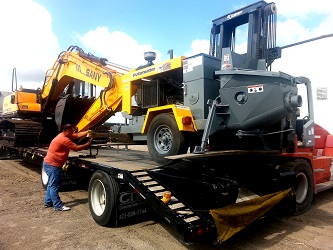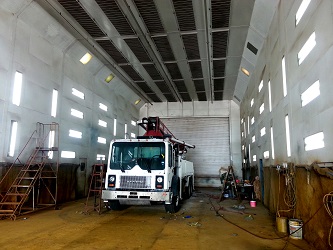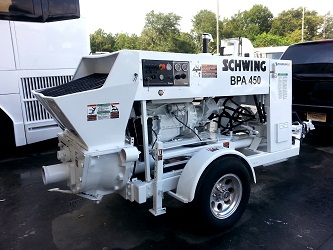
Lista de Correo
Síganos…
Nuestras Marcas

Post Date: Ago 18, 2014
Concrete is used more than any other man made material around the world, in roads, bridges, homes, and buildings. Also, this versatile material is a primary building material for a whole variety of non-conventional projects like parking lots, walls, and architectural applications.
Concrete powers a 35-billion dollar industry, employing more than 2 million people in the USA alone. The impact of this durable and sustainable construction material in our everyday lives is considerable. For over 100 years, mechanical concrete pumps followed by hydraulic driven pumps have reduced the back-breaking labor required to put concrete where it is needed. Concrete pumping machines boost the popularity and affordability of concrete and guarantee a healthy future for the concrete industry.

Concrete pumps expand the imagination for the owners of construction projects, for the architects who design them, for estimators who budget for them, and for the contractors who will build them. These versatile machines make it possible to place concrete higher and farther that would be possible without them. They save on construction costs and speed up the process, while providing a safer and more environmentally responsible construction process. With all these advantages, concrete pumps and the businesses that sell and operate them have a secure future.
For more than 75 years, hydraulic concrete pumps have been a reliable conveyance of concrete. From the tallest buildings to the farthest reaches that challenging job sites required. But more than that, concrete pumps have evolved in many shapes and forms to become every day tools in commercial, industrial, and residential projects. No matter the size or complexity of the job, some version of this versatile, time-saving machine provides faster and safer placement with less cost than the manual labor that they replace.
Boom Pumps

Truck-mounted concrete boom pumps can deliver concrete as high as 235 feet from the ready mix source. This range enables a boom pump to cover tens of thousands of square feet from one location while pumping more than 200 cubic yards per hour or as fast as the ready mix concrete trucks can discharge their loads. Medium size boom pumps can pour multiple house foundations in a day. Their vertical reach expands the use of concrete as a material for above grade-walls for both conventional forming and insulated concrete forms that require the smooth even placement of a concrete pump. In many cases concrete boom pumps can reach over job sites where entry to continue construction is not permitted and truck mixers should not back up into a site. Use of a boom pump also prevents mud from being dropped on the street by keeping ready mix trucks on the pavement.
Concrete pump manufacturers have created specialized booms that work indoors or while detached from the pump. This enables concrete pumping at greater distances from the pumping source.

Trailer-Mounted Pumps
Pumps mounted on trailers require a pipeline system to be laid out to pour at a desired location such as a patio, swimming pool, parking lot, or even a mezzanine. For high rise construction, trailer-mounted concrete pumps place concrete as high as 1,000 feet up often aided by a placing boom. The placing boom reduces the manpower required by placing the concrete more precisely and quickly.
Concrete Pumps are Here to Stay
The reliability of concrete pumps is without question whether placing thick core walls with high strength concrete or pumping continuously for days on silos. Pumping complements many forms of concrete construction including tilt-up where pumps fill onsite forms to be lifted in place for fast-track construction and placing precast box sections to speed construction of a bridge. The versatility of today’s concrete pumps allow other advantages with other cement-containing materials such as pumping shotcrete for pools, structural walls, or even repairing a concrete garage. Grout pumping fills voids to stabilize soil caused by sinkholes or to rehabilitate underground sewer lines.
Flowable fill has become a popular material to replace compacted fill, and benefits from placing with a pump. Bottom line is, whatever concrete is needed, a pump can usually place it thanks to a mature industry that has used their imagination and modern equipment to establish the pumping industry as vital to the growth of concrete.
Source: ACPA presentation on Concrete Pumping: The Future of Concrete Construction
Feature image source: Gavin Houtheusen/Department for International Development








Since there are different types of pumps, I think that it will greatly help out the construction industry. Anything to make your job easier is always a good thing. One of the things about having a good pump is that you can put the concrete virtually anywhere. How do you think they get concrete to the top of skyscrapers?
Hi there, they do it by placing Pipe line systems to the walls of the skyscraper, these are attached with U bolts, and they increase the height by adding more pipes as they go up.
Wow, I had no idea that concrete pumps helped construction processes so much! Just the fact that they can be used to place concrete up to 1,000 feet up is absolutely amazing. I would love to see something like that in action, especially at its maximum range. Since 1,000 feet is really, really high, I’m guessing that the maximum range of those trailer-mounted pumps is only needed for high-rise buildings or offices.
Seeing how several construction crews in my town are using concrete pumps also got me asking if all construction sites are now doing this. It seems like almost every home in my neighborhood are being built by concrete. The thought of had reminded of my own father who pumped concrete on the base of his house.
I have seen these concrete pump at construction sites, and I thought that it was interesting that it can go so high. 235 feet in the air must be very helpful if the concrete needs to be on a higher level. I wonder if more sites will be using these types of pumps because they are so useful?